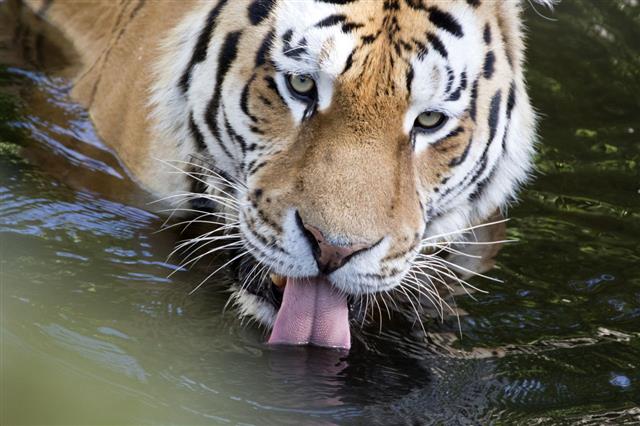
Siberian tigers are the biggest cats on our planet and also an endangered species. To know more about these interesting animals, Read on…
Siberian tigers are massive carnivores living in the earth’s coldest areas. Siberian tiger or Amur, the world’s largest cat, is amongst the most endangered species. Nowadays, these magnificent animals are mostly found in southeastern Russia. Their number in China and Korea has reduced a lot because of illegal poaching. It is estimated that around 350 – 400 tigers are left in the wild and 490 are there in zoos.
Facts about Siberian Tigers
The Siberian tigers are huge and possess and imposing body frame. These burly creatures can weigh up to 650 pounds and are about 10 to 12 feet in length. Their average weight is about 400 to 650 pounds. Their height measures 3 to 3½ feet till the shoulders when in a standing position. Skin color is pale-orange with black colored stripes. White Siberian tigers have chocolate colored stripes lined against their white coat. Maturity is reached between the age of 3 to 5 years and they have no particular mating season. The gestation period ranges between 3 to 3½ months. The cubs are born blind and therefore protected by the mothers in their early days for about 8 weeks; after which they roam around accompanying her. At the age of 1 year, they assist their elder ones in hunting. These tigers attain full growth at the age of 3 years, which is when they start hunting on their own.
What do Siberian Tigers Eat?
They need 20 pounds of meat for their daily diet. They primarily eat deer, elk, and wild pigs. Monkeys, fowls, frogs and fish form their diet in times of food scarcity. On an average, only 1 out of their 10 hunting attempts are successful. As per records, a tiger is known to have traveled more than 600 miles in search of food. An adult tiger can eat even 200 pounds of meat in a single day, and as much as 100 pounds at one sitting. It uses the method of ‘ambush’ while hunting. Although these tigers run with great speed, they need to come within 30 to 80 feet distance of their prey in order to launch an attack.
Where Do Siberian Tigers Live?
These tigers prefer to live a solitary life and have large territories; some of these areas being greater than 4000 square miles. Females generally live in families and take care of their cubs. Originally, these tigers were present in large numbers in Russia, China and Korea; but poaching has brought down their number drastically. Tigers are generally killed to obtain their precious skins, however in China their body parts are used for the preparation of some medicines. Today, the Siberian tiger’s habitat is confined only to far eastern Russia.
Some Interesting Facts
It is time to obtain some interesting information about the Siberian tigers. You would find some useful facts to include in your school essays.
- The local people living in Siberia have great respect for these tigers. The Tungusic people refer to the Siberian tigers as ‘Old Man’ or ‘Grandfather’, while the Nanai people have named them as ‘Amba’.
- Unlike the Bengal tiger, Siberian tigers are rarely man-eaters. Only six incidents of man-eating have been recorded in the whole of the 20th century.
- On December 25th, 2007 a Siberian tiger – ‘Tatiana’, was gunned down after its escape from a San Francisco zoo. The tiger had killed one person and injured two others.
- There have been incidents of bears being killed by these tigers. It happens only when the ungulate population drops down and the tigers have to search for some alternative food source. Brown bears are more vulnerable to tiger attacks as compared to the black bears. This is due to the brown bears’ inability to climb trees.
- Siberian tigers that live in the wild survive for as long as 15 years, but those in captivity have a smaller life span.
- Unlike their orange skinned counterparts, white Siberian tigers live a long life in captivity as compared to that in the wild.
- Siberian tigers can survive heavy frosts.
- In case of a fight, they warn the intruders beforehand by rattling their tail.
- Though the male tiger fights for its territory fiercely, it won’t harm an intruder female with cubs.
- The shrinkage of Siberian tiger habitat is one of the main reason, apart from poaching that has reduced their numbers. In most cases, the logging has been carried out illegally.
- The Wildlife Conservation Society (WCS), Russia has taken up the Siberian Tiger Project (in 1992) with the objective of preparing conservation plans for these creatures. Collecting information on the topic of tiger ecology is one of the important tasks assigned to the WCS.
- The number of Siberian tigers in wild had reduced to mere 40 in the decade of 1940s. However, the joint efforts taken by different organizations in Russia, including the World Wildlife Fund (WWF) have led to a steady rise in the tiger population.
Preserving the Siberian tiger is the need of the hour. Sincere efforts are needed to protect this strong, yet vulnerable creature. Let’s try our best and help in any way possible to save the Siberian tiger!






